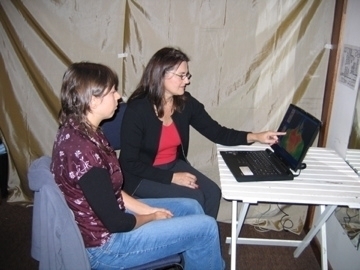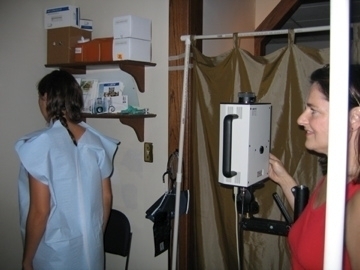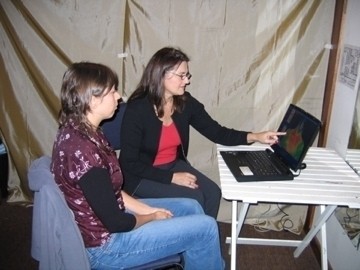
DITI is a radiation free, contact free, non invasive (symptom-free), state of the art clinical screening test recommended for women of all ages. This test is part of an early breast disease detection and prevention program that provides women an opportunity to greatly increase their chances of addressing early stages of cancer and other breast disease. Unlike conventional mammography, DITI is completely safe for pregnant women, women with breast implants, and women with large, dense or sensitive breasts, since there is no contact with or compression of breast tissue. DITI has been recognized as a viable diagnostic tool since 1987 by the AMA Council on Scientific affairs and the ACA Council on Diagnostic Imaging, since 1988 by the Congress of Neuro-Surgeons, and since 1990 by the American Academy of Physical Medicine and Rehabilitation.

The screening at Ecopolitan (the ONLY DITI currently available in the Twin Cities) includes a full thermographic imaging examination and color images, interpretation of the non-breast tissue findings by a Certified Thermographer, and medical interpretation by a medical doctor who is a board-certified radiologist.
A tumor must grow to nearly the size of a small grape before it becomes visible on a mammogram. Most breast tumors have been growing slowly for up to 20 years before they are found. DITI is the only screening method available that detects angiogenesis (a group of blood vessels formed by the tumor for food and oxygen) when the tumor may be at its minutest physical stage of development (no larger than the head of a pin), and when it is still relatively easy to halt and reverse the cancer's progression. It takes years for a tumor to become life threatening. With the currently commonplace absence of preventive efforts, early detection is the key to saving lives.
How does DITI work?
DITI is a non-invasive technique that allows the examiner to visualize and quantify changes in surface temperature. Metabolism within all our living cells causes the emission of heat energy, which is picked up by the blood circulation for equal distribution in the body. Thermography can register these heat emissions and any areas of increased or diminished flow of energy, thereby providing insight into the functional physiological status of a given area, such as the breast. During the exam, the sudden exposure of the breasts to cold air causes healthy blood vessels (NOT abnormal blood vessels found in cancer) to constrict, leading to higher temperature readings in the dilated, highly vascular, often-inflamed cancerous areas. This difference in infrared energy between cancer cells and healthy cells accurately pinpoints the tumor process. An infrared scanning device ("camera") is used to convert infrared radiation emitted from the skin surface into electrical impulses that are visualized in color on a computer monitoring. This visual image graphically maps the body temperature, pixel by pixel, and is referred to as a thermogram. The spectrum of colors indicate an increase or decrease in the amount of infrared radiation being emitted from the body surface. Since there is a high degree of thermal symmetry in the normal body, subtle abnormalities and asymmetries can be easily identified.
Medical DITI has been used extensively in human medicine in the USA, Europe and Asia for the past 20 years (it should not be confused with the older, less accurate, NON-digital thermography of the 70's and early 80's). DITI's major clinical value is in its high sensitivity to pathology in the vascular, muscular, neural and skeletal systems and as such can contribute to the diagnosis and therapeutic interventions offered by the clinician and preventive measures (including nutrition, exercise, stress-reduction, Infrared Sauna, oxygen therapy, etc.) employed by the patient and her counselors.
According to the National Cancer Institute, the number of American women expected to be diagnosed with breast cancer sometime during their lives has increased significantly over the years: It was one in 20 in 1950 -- one in 9 in 1995 -- one in 8 in 1999. Transformation of cells towards malignancy is accompanied by release of compounds (prostaglandins) that stimulate the proliferation of small blood vessels, which are necessary to support the growth of a tumor. These vessels form a chaotic network of thin-walled, blood-filled capillaries that traverses the tumor mass. This leads to a diagnostic DITI signature, related to stereotypical production of heat, asymmetry, and structural differences seen with these tumor-associated blood vessels.
Mammography is uncomfortable, at times even painful for women. It is only 40% to 60% accurate for pre-menopausal women or menopausal women taking synthetic hormones, and considerably inaccurate for women with large breast (and completely contra-indicated for women with breast implants). It is most accurate (81%) with postmenopausal women. Thus, it has a high incidence of "false negative" results (that is, no findings despite the presence of cancer, thereby missing the opportunity for early intervention). Additionally, according to the highly-respected Lancet Journal, up to 93% of the 5% of mammograms that suggest further testing end up "false positives" (that is, follow-up biopsies indicated no cancer was present) resulting from dense or fibrocystic breast tissues (present in up to 30% of women). All these unnecessary biopsies are injurious to healthy breast tissue and carry various risks of which the patient is rarely informed. Furthermore, mammography exposes the breast to damaging radiation, which may actually contribute to the development of breast cancer (according to John W. Gofman, M.D., Ph.D., an authority on the subject). Therefore, The Lancet concluded that mammography is not an acceptable wide-spread breast screening procedure. It is only needed to pinpoint the precise location of established, well-developed breast tumors.
In contrast, infrared breast thermography is 86% to 96% accurate for indicating the presence of cancer in pre-menopausal women. There are almost never any "false negatives" (cancers are almost never missed), only what APPEARS to be "false positives." Many of these so-called "false positives" (discovery of abnormal findings without "proof" of clinical cancer) of DITI breast screening may very likely represent the "TRUE positive" findings of angiogenesis that precedes actual tumor development. Detection in such early stages is unreliable by conventional means (self exam or mammograms), since the tumor has not yet developed sufficient density or size.
DITI is especially useful to younger women between 30 & 50 (or even younger, for the sake of prevention) whose denser breast tissue significantly reduces the effectiveness of mammograms. Breast cancers tend to grow about twice as fast in women under 50, creating much more life-saving diagnostic Infrared radiation. DITI is a must for women who can't or won't have a mammogram (women who had surgery, implants, scarring, or other contraindications, or who fear the radiation or discomfort associated with mammograms), women with personal or family history or lifestyle history (as in exposure to smoke) of significance to breast cancer, and women of all ages who are interested in early detection and prevention.
DURING THE TEST
To protect the patient's privacy, the number of people involved in the procedure will be kept minimal. The room air should feel mildly cool to the breasts as they adjust to the room temperature. The procedure is totally non-invasive, and the sophisticated equipment non-threatening, quickly quelling any apprehension the patient may have. The camera does not emit radiation of any kind. There is no pain or compression of the breasts. During the examination, the woman stands bare-chested about 3 feet from the device. As the imaging takes only minutes to generate, she is able to view the displayed images and receive immediate explanations regarding all the non-breast-related findings (vascular, muscular, lymphatic, and skin findings, with implications for the associated neurological, digestive, and other tissues or organs).
The entire appointment lasts 30 minutes.Within 7-10 days, one color copy of the images together with the medical radiological interpretation (performed by a board-certified M.D.) will be received at the referring health care practitioner's office, or at the patient's address (if self-referred or if so desired).
The results will either assist in diagnosis (especially in conjunction with other diagnostic or suspicious findings) or in establishing of a baseline pattern to which all future thermograms will be compared. Any changes indicating departure from this baseline will warrant further investigation or treatment. As with all other diagnostic tests, there is never a 100% guarantee of detection of a lesion, although DITI has been proven to be overall extremely sensitive in comparison with other breast tests.
Costs and Registration
The cost for the entire procedure, reports, mailing of the color copy, and medical radiological interpretation is $195. This takes into account the transportation of equipment and airfare for the thermographer (from California). Payment is made directly to the thermographer at the time of the appointment.
To register ONLY, call Doctor Tel-Oren's assistant at 612-870-2974.
Preparation for DITI (Digital Infrared Thermal Imaging) Breast Screening
- Lotions or powder should not be used on or around the breast or armpits before the test. No smoking, vigorous exercise, sauna, niacin (vitamin B-3), or spicy foods are allowed for at least 3 hours prior to the test, because of their effect on the circulation.
- To perform the test, all upper body clothing and jewelry must be removed (behind a full privacy curtain), and a surgical gown will be supplied.
- The thermographer must be informed of any recent skin lesions on the breast, which may cause false positive results because of inflammation.







